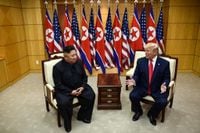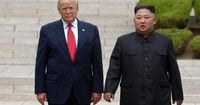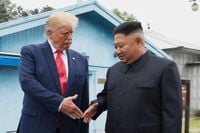Speculation is once again swirling on the Korean Peninsula, as U.S. President Donald Trump prepares for his first trip to Asia since returning to office. The focus? A possible face-to-face meeting with North Korean leader Kim Jong Un during Trump’s stop in South Korea for the Asia-Pacific Economic Cooperation (APEC) summit, scheduled for October 31 to November 1, 2025. If realized, this would mark the first summit between the two leaders since their impromptu encounter at the border village of Panmunjom in June 2019, and their fourth overall.
As reported by the Associated Press, the last Trump-Kim meeting was a surprise—arranged with little warning, and meant to revive faltering nuclear talks. Now, with Trump set to visit South Korea following stops in Malaysia and Japan, rumors of another summit have set off a flurry of diplomatic and economic speculation. South Korea’s Unification Minister Chung Dong-young told lawmakers in mid-October that a meeting at Panmunjom is “possible,” citing recent suspensions of civilian tours to the area and Kim’s own hints about returning to talks.
But is a Trump-Kim handshake really in the cards this time? Many experts are skeptical. According to CNN, while Trump administration officials have privately discussed the potential for such a meeting, no serious planning has taken place, and communication between Washington and Pyongyang remains far weaker than during Trump’s first term. The Associated Press also notes that neither government has signaled any high-level meeting ahead of the APEC summit.
That hasn’t stopped the rumor mill—or the financial markets—from reacting. As detailed by South Korean media and CNN, shares of companies tied to inter-Korean cooperation, often called “unification-themed stocks,” rallied sharply on October 20 and 21, 2025, following news of possible Trump-Kim talks. Ananti, a resort developer with projects in North Korea, saw its shares rise 6.63% in a single day, while Hyundai Elevator, linked to cross-border tourism, gained 4.4%. Clothing manufacturers Shinwon, Codes Combine, and GoodPeople—firms that once operated in the shuttered Kaesong Industrial Complex—jumped by 6.79%, 14.9%, and 12.12%, respectively. Construction and materials companies such as Ilshin Stone also saw a 5.72% spike.
But just as quickly as optimism surged, it faded. On October 22 and 23, shares slipped after North Korea test-fired ballistic missiles into the East Sea, marking its first launches in five months and escalating tensions ahead of the APEC summit. This whiplash reflects a familiar pattern: unification-themed stocks have a history of swinging wildly with the political mood, soaring on peace overtures and tumbling when tensions rise. A researcher at a local finance institute, speaking anonymously to CNN, cautioned, “Stocks related to inter-Korean relations tend to move on speculation and political news, rather than real business performance, such as earnings, assets and operations. Recent rallies on these themed stocks could be short-lived if there is no tangible diplomatic progress.”
This cycle is nothing new. The last major surge and crash in these equities occurred in 2018 and 2019, as optimism over U.S.-North Korea summits lifted South Korean stocks tied to cross-border collaboration. The so-called “unification rally” took off when North Korea joined the PyeongChang Winter Olympics, and accelerated with the first inter-Korean summit between President Moon Jae-in and Kim Jong Un at Panmunjom. Construction, tourism, and railway firms soared on hopes of new projects, only to plummet after the collapse of the second Trump-Kim summit in Hanoi in early 2019. On the day talks broke down, more than 5.59 trillion won ($3.89 billion) was wiped out from these stocks, according to the Korea Exchange.
So, what’s changed since 2019? Quite a lot, say experts. Kim Jong Un has accelerated the expansion of North Korea’s nuclear-capable missile arsenal and deepened diplomatic ties with Russia and China. Enforcement of U.N. sanctions has weakened, and North Korea’s leverage on the world stage has grown. As Ban Kil Joo, assistant professor at the Korea National Diplomatic Academy in Seoul, told the Associated Press, “We should see prospects for their meeting have increased,” but the context is very different this time around.
Kim’s urgency for talks may actually be lower now, given his strengthened position. In September 2025, Kim broke his silence on Trump’s outreach, saying he holds “good personal memories” of the U.S. president and might return to talks if Washington drops its “delusional obsession with denuclearization.” Trump, for his part, has continued to praise Kim as “a smart guy” and expressed a desire to restore diplomacy. But as Kim Tae-hyung, professor at Seoul’s Soongsil University, put it, “Considering the current situation, it seems difficult to imagine Kim Jong Un coming over for talks.”
Analysts caution that even if a meeting does occur, it may not produce meaningful results. Koh Yu-hwan, former president of South Korea’s Institute of National Unification, told the Associated Press that Trump would need to bring something truly enticing to the table to get Kim back to negotiations. The U.S. maintains that sanctions will remain unless North Korea fully abandons its nuclear program—a stance that runs counter to Kim’s demand for recognition as a nuclear power and the lifting of sanctions.
There’s also the risk of unintended consequences. Some experts warn that any deal involving partial denuclearization could still leave North Korea with short-range nuclear missiles targeting South Korea. Kim Taewoo, another former head of the Institute of National Unification, argued that even “such a small deal would still benefit South Korea’s security because decades-long efforts to achieve a complete denuclearization of North Korea have made little progress.” However, others worry that relaxing sanctions in exchange for limited steps could trigger calls in South Korea and Japan for their own nuclear weapons—a destabilizing prospect for the region.
Despite the uncertainty, both hopes and anxieties remain high. Some see a potential Trump-Kim meeting as a rare chance to ease the growing danger posed by North Korea’s arsenal. Others remain wary, recalling how quickly optimism can turn to disappointment on the peninsula. As Chung Jin-young, former dean at Kyung Hee University, summed up, “If a meeting with Kim Jong Un happens, Trump would brag of it and boast he’s the one who can resolve Korean Peninsula issues as well, so he has something to gain ... But would the U.S. have something substantial to give Kim Jong Un in return?”
For now, the world watches and waits. The coming days may reveal whether diplomacy will take center stage again, or if the cycle of hope and tension will continue its familiar spin on the divided peninsula.


